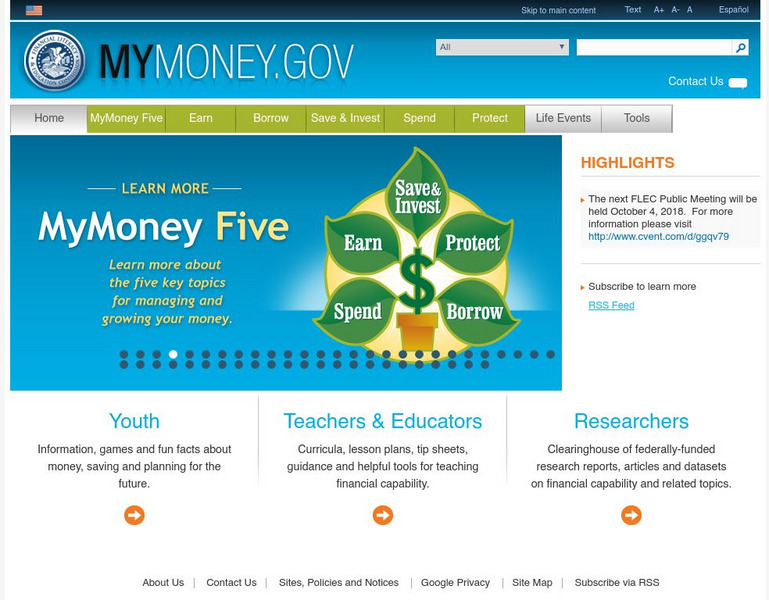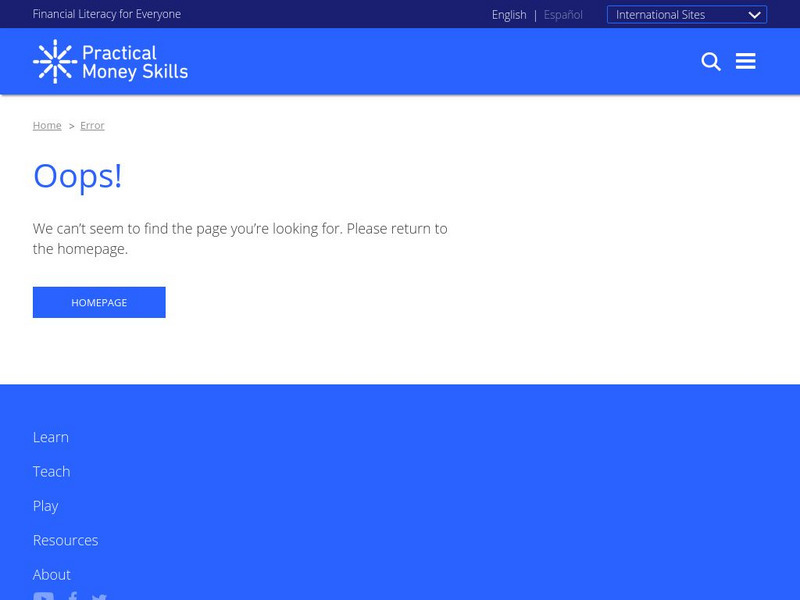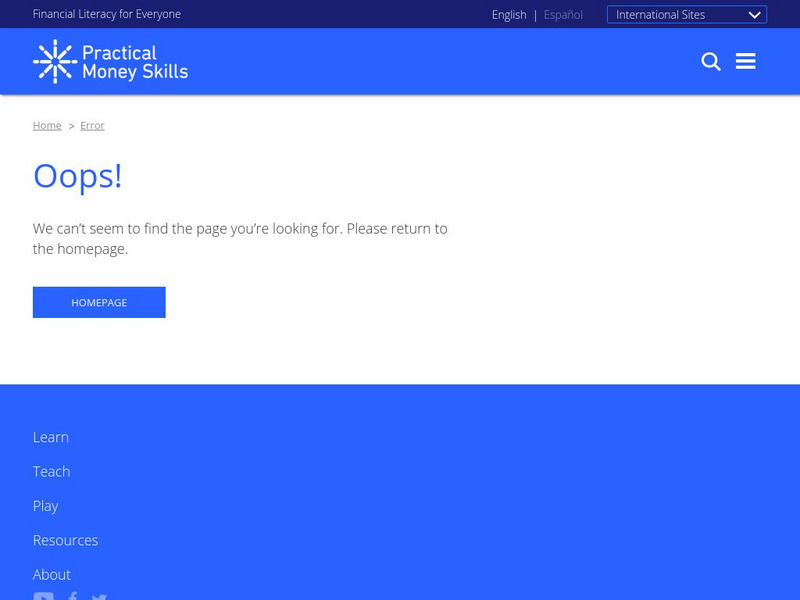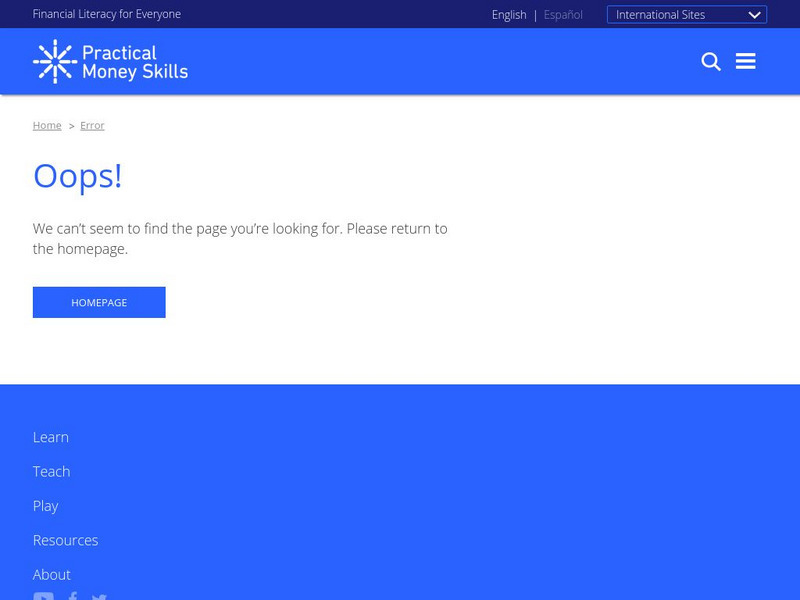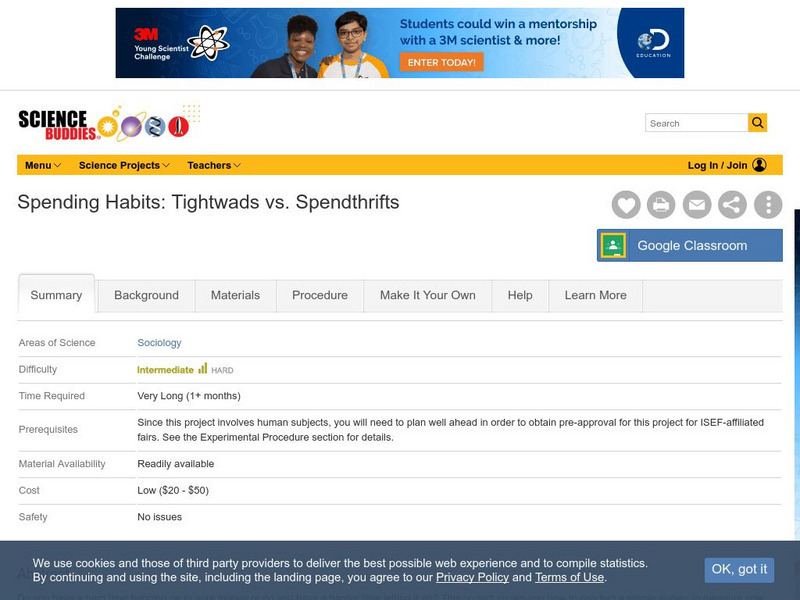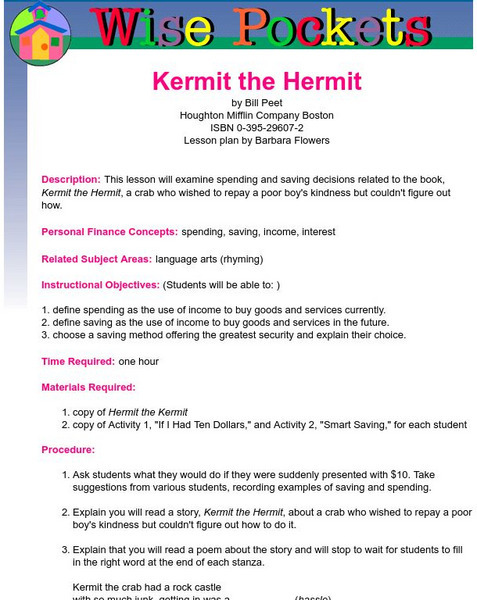Other
Bank of America: 8 Simple Ways to Save Money
This site discusses eight way to save money including recording spending, saving for a goal, making a budget, plan on saving, choose something to save for, and pick the right tools.
Scholastic
Scholastic: Adventures in Math: Lesson 1: Saving Money for Your Future
Tips for learning the value of saving money to achieve your financial goals.
Practical Money Skills
Practical Money Skills: Lesson Two: Spending Plans
This instructional activity introduces children to the concept of dividing their money into categories, namely "save," "spend," and "share" and presents activities that will help them understand that money is limited in quantity and must...
Consumer Financial Protection Bureau
Consumer Financial Protection Bureau: Saving for Post Secondary Education
Students use an online compound interest calculator to answer questions and create charts that show the value of saving money over time for future education goals.
Illustrative Mathematics
Illustrative Mathematics: 2.nbt Saving Money 1
In this lesson plan students use strategies based on place value to add and subtract within 100.
PBS
Pbs Learning Media: Sesame Street: Financial Education
Every goal starts with taking the first step. Teaching kids to save money by collecting in a specific place such as a piggy bank or a jar shows kids concretely how much they are saving. Every time you save up to a certain small, new...
Other
My Money
This Federal Government website provides consumers with many resources and much information to help them to manage their money better. Topics include budgeting, taxes, saving, investing, retirement planning, credit, and checking...
Other
Finra Investor Education Foundation: Introduction to Earning Interest 11 & 12
Students will know and be able to use the formula for calculating compound interest and understand the effect of compounding on savings in this lesson.
Practical Money Skills
Practical Money Skills at Home: Saving and Investing
Teach children the value of saving and investing their money using these suggested ideas. Activity offers real-world experiences that will help children better grasp these concepts. Links to related websites and worksheets are included.
Practical Money Skills
Practical Money Skills for Life: Lesson Plans
A series of financial literacy lesson plans broken out by grade range for grades from Pre-K through college, with an additional set of lessons created for students with special needs.
Council for Economic Education
Econ Ed Link: Money Comes and Goes
Students read two online stories that introduce them to the elements of a budget and show that a successful budget balances money coming in (income) with money going out (expenses and savings). Follow-up activities point out the value of...
PBS
Pbs: Financial Literacy: On the Money
Explore PBS's "On The Money," program for teens to investigate teens & money, budgeting, bank accounts, credit cards, calculators, and moneymaking ideas.
Practical Money Skills
Practical Money Skills at Home: Allowance and Savings
Ideas to teach children the importance of saving and the value of an allowance using this activity. Suggestions for conveying these ideas include related worksheets to help children better grasp these concepts.
Practical Money Skills
Practical Money Skills at Home: Allowance and Work
This collection of activities focuses on strategies for teaching teens how to balance allowance, chores, school, and work. Also provided are practical tips for parents regarding signs to look for that may indicated earned money is being...
Science Buddies
Science Buddies: Spending Habits: Tightwads vs. Spendthrifts
Do you have a hard time hanging on to your money or do you have a harder time letting it go? This project shows you how to conduct a simple survey to measure how people manage their money. Find out what percentage of your classmates are...
Other
Money Management International: The Berenstain Bears' Trouble With Money
A lesson plan featuring the Berenstain Bears that introduces the concepts of spending, goods, services, income, saving, and interest.
University of Missouri
University of Missouri St. Louis:wise Pockets: Kermit the Hermit
This is an elementary level lesson that deals with spending, saving, income, and interest. Requires the book Kermit the Hermit by Bill Peet. Includes detailed lesson plan along with procedures and activities.
Other
Wyoming Retirement System: Sonia Meets Her Future Self
PDF comic book character, Sonia, a 6th grader, meets several future versions of herself and learns about saving for retirement.
Learn My Way
Learn My Way: Smart Internet
In this online course, students will learn about the different ways to connect to the internet as well as how to save money on your internet connection.
USA Today
Usa Today: Workers Adjust Habits to Save on Gas Costs
This article focuses on the impact on higher gas costs on workers and companies.
Council for Economic Education
Econ Ed Link: Opportunity Cost
Consumers are faced with tough choices because so many innovative and exciting products and services are available. Therefore, engraining a decision-making process that includes considering of opportunity cost is necessary to shape...
Council for Economic Education
Econ Ed Link: Work, Earnings and Economics: Using Lyddie by Katherine Paterson
In reading and discussing Lyddie, by Katherine Paterson, students examine basic economic concepts and explore the growth of labor unions and the role of government in a market economy.
Calculator Soup
Calculator Soup: Rule of 72 Calculator
Use the Rule of 72 to estimate how long it will take to double an investment at a given interest rate. Divide 72 by the interest rate to see how long it will take to double your money on an investment.
Other popular searches
- Spending and Saving Money
- Saving Money Activities
- Earning and Saving Money
- People Saving Money
- Saving Money Lessons
- Saving Money for Kids
- Saving Money Games
- Budgeting and Saving Money
- Saving Money Interest
- Saving Money for Vacation
- Saving Money Teens
- Saving Money Strategies



